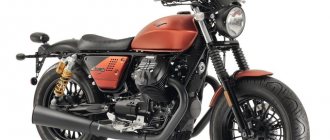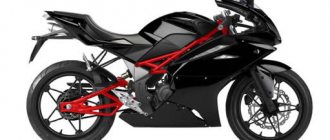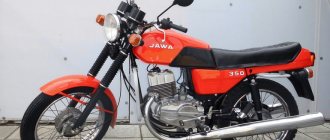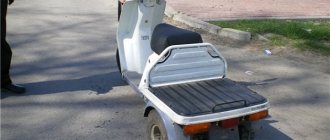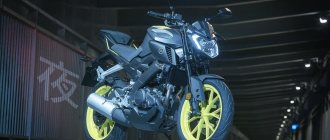Italjet Dragster 180
Space frame Italjet
Dragster
Italjet Dragster
(1998-2003) from the Italian manufacturer Italjet Moto is the only mass-produced scooter with RAAD forkless front suspension and frame. Alessandro and Leopoldo Tartarini received a patent for this combination in 1997. [1] A rebooted version has been introduced and is expected to be available from early 2022 [2] with 125 or 200 cc four-stroke engines. Cm.
000_moto_0112_032
Italjet Dragster 50: scooter, 2012, 49 cm³, 95 kg.
Italjet Dragster 50: scooter, 2012, 49 cm³, 95 kg.
Massimo Tartarini doesn't like awkward questions. Especially regarding the production location of the future Dragster. But, gritting his teeth, he still answers: the frame will be Italian, and so will the assembly, although “outsourced” - three hundred kilometers from Bologna, where Italjet’s headquarters is located. The rest of the components - at least most of them - will definitely be Asian. Plastic, brakes, shock absorbers. But the engine... The exhibition copy featured a Chinese copy of the “water-powered Minarelli”, the same as on the Aerox, but versions with both the Piaggio two-stroke engine and the “water” 125- and 278-cc engines of the same brand are planned for production. More powerful devices are also expected to have a 12-inch front wheel, allowing for a more powerful front brake.
But this is for the future. At least by the end of summer. Now we see the youngest model from the line - “fifty dollars”, which is in the photo. This device has already been certified, and sales are scheduled to begin in April (possibly in Russia: the potential importer is already negotiating with Massimo; I won’t say who exactly, so as not to jinx it).
The first thing that catches your eye is a completely new body kit. I won’t say what’s better than the previous one (“the tail” is interesting, but the previous “face” was more charismatic and more thoroughbred), but it’s a fact that overall it looks modern. The dashboard has also been seriously updated, but the steering controls are bulky and have an Asian feel. What’s also striking is the filling neck, which has “moved” from the left half of the “tail” to the tunnel between the legs, immediately after the front monoshock absorber. In the tunnel, the gas tank itself is an ideal solution in terms of weight distribution and handling. But, on the one hand, such castling simplifies maintenance and replacement of the battery, on the other hand, it makes you bow to the traffic jam every time at a gas station. And how can valves be adjusted on future four-stroke versions without dismantling the engine?
The front suspension (at least for now) is left unchanged, as is the steering gear on cardan joints, the wheels are the same as on the 125-180 cc “rocking” versions, and are also entirely borrowed from those Dragster 50s with a Minarelli engine, but the frame has been completely redesigned. The division into “long” and “short” frames is a thing of the past - now they will be unified for all models of the family. The “long” one is taken as the basis, but the main “pasta” are trusses of a larger diameter, and the lower longitudinal ones are spread out to the sides at the back. This greatly reduced the space for the legs (although the heels do not rest against the plastic, but only if you are sitting in civilian shoes, and not in road motorcycle boots), but now any medium-sized four-stroke bike will fit there - even a 278 cc Piaggio, even a 250 cc Yamaha - of course, if you weld the appropriate brackets to the frame and attach the desired “rocking chair”.
The plans include equipping the model with Piaggio engines (50 cc two-stroke, 125 and 278 cc 4-valve), an electric version... And a 12-inch front wheel with a more efficient brake!
The 278 cc engine is still only in Massimo’s plans, but today we see... a good preparation for building a street machine! So all we have to do is keep our fingers crossed so that this plate of minced meat and hot sauce doesn’t turn into a long noodle for our ears. For now, everything looks very convincing - but more on that in the next issue.
Text reading time - 4 minutes
“What is meant for you, no one will take.” Italian wisdom.
In 1955, Leopoldo Tartarini, a young and promising pilot and development engineer of Ducati, while competing in competitions, got into a serious accident, which would radically change his whole life and sports career. From the race track, Leopoldo is taken to the hospital, where doctors give him a disappointing diagnosis - a spinal fracture. Prospects quickly emerge - the guy will not be able to walk and will be confined to a wheelchair.
But that's not what the story is about. This is a story about a miracle, about a journey, about creating a fantastic design.
Back in September 1957, a solemn ceremony took place to see off two Ducati workers on a round-the-world trip from Italy to India, Australia, New Zealand, South America, North Africa and again through Europe to Italy. The pilots had to overcome such a long journey of 60 thousand kilometers on Ducati 175 motorcycles, which they prepared for the trip themselves.
During the year of their intensive journey, the pilots managed to survive the most incredible tests, and, given the poor technical development of communications at that time, they can safely be called heroic. Problems with visas, various diseases, driving in sub-zero temperatures and at night, attacks by wild animals in Africa and thieves in South America and many other difficulties. In Syria, for example, due to the civil war, the authorities gave travelers only 24 hours to cross the country (1,400 km). They completed it only 2 hours later than the allotted time, passing their first LJ standard (just kidding). But, despite all the tests of the strength of two iron and two human organisms, the trip ended successfully a year later, and the travelers returned to their hometown of Bologna, becoming national heroes.
Who were these brave guys? One of them was Ducati export sales manager Giorgio Monetti, and the other was Ducati engineer Leopoldo Tartarini... Yes, yes, the same Leopoldo who should have been confined to a wheelchair, but this did not happen thanks to an incredible miracle. Fate gave Leopoldo a second chance; soon after the accident he began to feel his legs, and after a month of hard training he began to walk on his own.
Almost immediately after traveling around the world, the young engineer Leopoldo begins to develop his own enterprise for the production of mopeds with MZ, Minarelli and Sachs engines, which will later receive the proud name Italjet Moto.
Also, the newly-minted entrepreneur works not only on his own projects, but also continues to collaborate with Ducati until the 80s - until Ducati comes under the management of Cagiva. It is important to note that despite all the difficulties of working with Ducati, Leopoldo's ingenious hand left its imprints on many motorcycles of this legendary brand.
The development of our own brand has been rapid and varied all these years. Each bike that came out was a technical breakthrough of that time and (which is what the products of this brand have always distinguished themselves from) had its own unique design. Tartarini invented incredible technical solutions for his motorcycles, sometimes so ingenious that this was a problem in the way of selling such products.
One of the outstanding achievements of the Italjet brand was the Dragster model, produced from 1998 to 2003. It was a high point in design and technical innovation for the company.
A birdcage frame, a curious layout and design of the front chassis, apparently created under the impression of the Yamaha GTS1000 and Kawasaki Nessie II, a single-cylinder two-stroke engine 180 cc with a power of 19.4 l/s at 8,000 rpm (!) (there were also models with an engine capacity of 50, 125 and 250 cc), a step seat and all this is packaged in a space design. Owners of these devices could mainly be found at drag racing championships, karting tracks and mountain serpentines, as well as in workshops and tuning studios. They also liked to say the following about this bike: “It’s very difficult to ride a Dragster 180 calmly through a quiet residential area, but those who buy this bike won’t want to do it anyway.” Italian hooligan, no less!
I remember this model very well, I was 17 years old at the time and I had just passed Category A at a motorcycle school. In my school bag there was always a photograph of a bright yellow Dragster cut out from a magazine; it was a kind of amulet of mine and reminded me from time to time that motorcycles are my passion and someday I will have this exotic motorcycle (call it a scooter) in my garage I can’t turn my tongue).
It seems to me that in order to create such a beautiful motorcycle you just need to do what is destined for you and all your past experiences (racing, serious injury, grand journey, working with Ducati, etc.) will only contribute to this.
Has anyone had the opportunity to ride this bike? What are your impressions? Share.
Next time I’ll tell you about the latest motorcycle in my ideal garage. And if you haven’t read about the other two yet, please follow the links: Suzuki TL1000S and Honda VTR1000SP.
001_moto_0112_032
Driving ergonomics have not changed.
And the passenger... appeared - the thin convex rear seat on the previous model made it possible to carry “ballast” only from the bar to the metro. The new plastic is certainly more modern than the 1996 model. And the rear one is even better. It’s just that the new design lacks purebredness. Driving ergonomics have not changed. And the passenger... appeared - the thin convex rear seat on the previous model made it possible to carry “ballast” only from the bar to the metro. The new plastic is certainly more modern than the 1996 model. And the rear one is even better. It’s just that the new design lacks purebredness.
Italjet Dragster: Found and restored the legend
The Italian “Valley of Motors” is a cult place. Ferrari, Lamborghini, Maseratti, Pagani and Ducati are assembled here - spit and you'll end up in a supercar factory. The place of power attracts extraordinary engineers, one of whom was Massimo Tamburini.
I received the device in this condition. The photo does not convey everything, fortunately.
His works include more than a dozen iconic motorcycles, one of the main ones being the Italjet Dragster scooter. The device divided the world of small two-wheelers into “before” and “after”. Then, in the late nineties, no one could believe that something new could be said in the world of scooters.
A homemade grille, broken turn signals and nothing working - definitely a must!
Cantilever front wheel suspension with a shock absorber in the center of an openwork tubular frame, a central monoshock absorber at the rear, disc brakes, liquid cooling, nothing cooler simply existed in those days.
A piece of plywood and leatherette nailed to it - this is what the passenger saddle looked like.
And the design! The device, as if carved from a piece of rock, shocked with its shape. A two-wheeled Lancia Delta Integrale, no less! Even today the device makes an impression, what can we say about the end of the “nineties”!
The cultural layer of putty, epoxy and reinforced tape is visible to the naked eye.
Today you rarely see such a device even at an exhibition, let alone for sale. And yet, sometimes they pop up. I got one of them: in terrible condition, two decades have not spared it.
A “collective farm” pipe, a running pump, dead brakes and a running gearbox—the complete set!
Dead tail, tired engine, suspension, electrics, almost nothing worked. The former owner also made me laugh because he drained ALL the fluids for the winter, including the brake fluid.
The “iron” was sandblasted and painted.
An attempt to find a fool was unsuccessful, so I managed to bring the price down to what I thought was acceptable at the time. An Italian legend, a cult device, all this is understandable, but the condition definitely hinted at an expensive repair.
Returning from there noticeably refreshed and rejuvenated.
Back then I had no idea how many problems there would be with him. The first is plastic. The empennage was almost complete, the only thing missing was the right “floor” and the original passenger saddle. Who knew that the preserved plastic was held together by putty, epoxy and other snot!
After painting and replacing consumables - a new pump.
I had to completely shake it up. I turned to a friend at the Weldplast company, where all the plumage was put in order. It turned out that the Dragster did not have a single living part - everything had to be repaired.
Surprise!
A separate conversation about the front fairing. The former owners made about a quarter of this part out of putty. It had to be restored from scratch; the original “face” on the Dragster could not be found even for a lot of money.
New parts, cleaned and painted - brakes look like new!
But we managed to find the pan and the left floor, and even new ones. The radiator grille and even the carbon fiber trim replacing the passenger seat were also found to be almost new. Almost complete!
Rivets are a great alternative to factory fasteners!
A few days of intensive work and all the plastic plumage was ready. Pre-assembly, finishing of gaps, fastenings, after painting it will be too late to change anything. And here he is, shabby, but already looking better than when we met!
The most difficult part is the front fairing, fantastic work by craftsmen!
The frame also had to be repaired. The former owner welded the side stand, throwing out the original central one. I had to weld a new, undamaged piece with brackets for the floor into the frame, and also look for the original stand.
We're back from renovations and ready to paint!
It was first sandblasted and then powder coated. A little welding, straight arms and voila! The device costs as the engineers at the factory intended!
But I couldn’t find the original rear shock absorber. The original one showed no signs of life, and the new original cost as much as half a scooter. I had to invent and select a suitable shock absorber from a Chinese pit bike.
New? No, I wash with “Laska”!
The new shock absorber fits perfectly into place, and the slightly thicker spring only made the appearance of the device more interesting. We also tidied up other parts of the rear suspension - painted the additional arm and replaced the bearing in the hub.
A unique original and a pathetic copy.
The hub itself turned out to be dead, the splines were licked off, and the former owner, without breaking off, simply drove nails into the broken splines. It works fine. Alas, there was nothing to restore here - the entire hub had to be replaced along with the crooked brake disc.
Feel the difference!
The brakes themselves were dead from start to finish. I even had to touch reinforced hoses with my hands! The calipers themselves didn't work either. I had to clean them of dirt and rust, paint them and replace all the rubber bands and pistons. In other words, nothing remains of the old brake mechanisms except the housings.
A non-standard side stand regularly tore out a corner of the frame that was not designed for such loads.
The brake machines also required repairs. The seals were leaking, and one didn’t work at all. Alas, it was not possible to find original repair kits, and there was no particular point in replacing them with used ones - they have the same dead rubber bands. I had to order tuning, much more elegant than the original.
A little Bulgarian music and you can weld a new piece.
But I managed to restore the pump, only the bearings and oil seal were tired - I found a repair kit, and at the same time I painted the body. Not only it, but also the variator cover, as well as the wheels, were coated with silver powder paint.
Small revision of the motor.
Discs are a separate conversation and topic for a story. For example, they have different diameters. The rear is a normal, commonly used 12-inch. There's plenty of rubber for this size, no problem. But the diameter of the front one is 11 inches.
Hello Curburetor!
Only a few manufacturers in the world make tires for this size; tire sellers don’t even have such a column in the search on sites where they have tires for 10 and 12 inches. Go find the right wheel! But that’s only half the battle: the valves in the wheels are also not standard.
Ignition coils, new and old.
While all modern scooters with tubeless wheels have regular automotive valves with a diameter of 10 mm, the Dragster has 8 mm ones. Tire fitters have heard about these, but no one has ever seen them. Even in Moscow I found only one office that sold such valves.
Variable speed drive. Yes, it also had to be changed, and at the same time a starter overrunning clutch had to be installed.
And so in everything! Difficult, expensive and very slow. The only thing that didn't cause any difficulties was the engine. Italjet was not a big company; it couldn’t afford to develop its own engine. Therefore, the Italians followed the usual path for small companies of that time and bought a ready-made motor.
Air filter.
Italian, of course. The Minarelli company built such cool small-capacity engines that Yamaha itself did not disdain purchasing it, which even cost engines for Formula 1!
There is a leak in the gearbox - the oil seal is tired.
It is not surprising that it was Minarelli engines that were installed on all Yamaha scooters of the 90s and 00s, as well as on many “Italians” in addition to Italjet. And then the Chinese also copied this engine, making their own clones.
Old paint and traces of repair, it seems that there is nothing to restore here, but nothing is impossible.
In other words, there were no problems with spare parts for it. Any original/non-original/tuning, all available. A couple of visits to stores and everything I needed plopped down to the bottom of the bag.
That’s how much it took for all the “gray” textured plastic.
The carburetor deserves special mention. I got the Dragster complete with a tuning Dellorto with a 21 mm diffuser versus the standard 14-inch one. It’s a good thing, if you don’t pay attention to how bad it is - a broken lid, tired gaskets, a jammed “suction” and many other little things hinted that there was a place for such “tuning” in ferrous metal.
The result is everything is like new!
But it turned out that the blessed Dellorto had all the consumables in stock. We managed to buy everything we needed for a reasonable price, so the carburetor quickly returned to service!
And then - everywhere.
At the same time, I managed to find the original air filter, replacing the standard filter element with a sports one with reduced resistance, and find the original exhaust - a rather rare part in our latitudes.
Guess which one is new and which one is painted!
The lighting equipment, with the exception of the headlight, went to the landfill; instead, I bought new turn signals and a brake light. The latter is not a shortage - the Italians ordered the rear turn signals and headlamp on the side, in the same place where they were ordered from BMW and Yamaha, so there were no difficulties in finding the original.
It was much more difficult to restore unpainted plastic. With colored everything is clear - putty, paint and go. But “textured” or, as it is also called, “structural” plastic is not so easy to restore. Fixing holes, yes, but restoring the look is much more difficult.
Assembly is a separate matter, there is no need to rush, you can spend a couple of weeks looking for suitable fasteners.
I had to manually wash off the traces of past repairs, remove them and repaint them. Fortunately, the store found a special structural paint for bumpers, which made it possible to accurately reproduce the original texture of “gray” plastic.
New lighting technology.
With it, as well as a couple of new details, such as the dashboard overlay, the device began to look much more interesting. The wire covers on the steering wheel deserve special mention - at the factory they were hidden in original springs, which I could not find.
If you see the new KAMAZ, take a closer look at its rear wheels.
Ingenuity came to the rescue. It turned out that the rear wheels of KAMAZ dump trucks have similar springs, which I bought. After a little shortening, they stood up like family, and with them the appearance became even more authentic. Now, apart from the brake machines, everything is factory!
Have you mastered the text? I worked on it for a long time, but it's nothing compared to the time spent on the device. Almost a year passed from purchase to completion of work. I won’t even count the money, so as not to get upset, the process was at the forefront here.
Bringing back youth to the iconic apparatus of the late nineties - yes, but that’s not the main thing; for me it was much more interesting to go through the process, to put the entire restoration through myself and my own hands. Finishing work brought not so much joy as a feeling of devastation; I wanted to take on something new.
More details in the logbook)
002_moto_0112_032
The main frame pipes (now only “long”) have become larger in diameter.
Production is still Italian. But the shock absorbers are Asian: what can you do, Paioli no longer exists... The main frame pipes (now only “long”) have become larger in diameter. Production is still Italian. But the shock absorbers are Asian: what can you do, Paioli no longer exists...
003_moto_0112_032
The tank and battery have swapped places.
It is now easier to tinker with the battery (which is important for “large” versions that do not have a kickstarter). But refueling will be inconvenient - and you will have to do it more often (the tank has shrunk almost in half!). The tank and battery have swapped places. It is now easier to tinker with the battery (which is important for “large” versions that do not have a kickstarter). But refueling will be inconvenient - and you will have to do it more often (the tank has shrunk almost in half!).
Yamaha XVS 1100 Drag Star (V-Star 1100) - cruiser in high-tech style
This bike was released on the eve of the twenty-first century. This can be seen at least from the design of the Yamaha XVS 1100 Drag Star. The technical characteristics of the motorcycle also speak of its modernity.
An interesting choice for those who love high-tech cruisers.
Appearance
The design is interesting primarily due to the front fender and two chrome pipes. The front wing increases significantly downwards, reminiscent of the wings of cars of the thirties and forties. The Yamaha XVS 1100 Drag Star, however, looks modern and innovative for its era.
The wheels here are spoked, however, if you look from afar, it may sometimes seem that they are cast, due to the isolation of the groups of spokes. The passenger seat is not equipped with a backrest. This makes riding with a passenger dangerous, despite the fact that the seat is slightly curved upward in the rear.
Comfort
The bike is comfortable to ride on spacious trails, where this large motorcycle can easily maneuver at low and medium speeds. In the city, such a vehicle will quickly tire. For example, if you have to turn around somewhere in the yard, then, firstly, it will not be easy, and secondly, it may sometimes end in repairs. After all, the clearance here is small.
Also, if a person rides such a bike in a traffic jam, he will have to periodically prop it up with his foot. And this bike is far from light. If you use such a machine in suitable conditions, it will only bring pleasure. Of course, if the rider is experienced enough to ride such a motorcycle.
Dimensions and weight
This is not the largest cruiser, but perhaps one of them. The length, height and width of this machine clearly show that this is an impressive bike. Of course, such dimensions and weight cannot but affect maneuverability. But this cannot be considered a disadvantage, because this class was initially distinguished by significant dimensions.
The Yamaha XVS 1100 Drag Star has the following dimensions:
- curb weight – 275 kg;
- seat height – 690 mm;
- ground clearance - 145 mm;
- wheelbase – 1640 mm;
- height – 1095 mm;
- width – 895 mm;
- length – 2405 mm;
- tank volume – 17 l.
The dimensions are impressive, as is the weight. And the tank volume is appropriate. Of course, with this you won’t be able to go without gas stations for very long, but this is not critical. All the same, you won’t be able to travel off-road on such a bike.
Specifications
The car is not particularly powerful, but such a cruiser does not require high engine performance. The local torque and power are enough to use the motorcycle comfortably. Of course, if you use the equipment for its intended purpose, like a cruiser.
If a person wants to drive one on a race track at top speeds, he most likely will not feel pleasure. This car is not designed for that.
| Power | 61.5 l. With. |
| Torque | 85 Nm |
| Maximum speed | 180 km/h |
| Acceleration to 100 | 5.2 s |
| Fuel consumption per hundred | 5.65 l |
| Drive unit | gimbal |
| Transmission | five-speed |
| Frame | tubular steel |
| Rear suspension | pendulum, monoshock absorber, stroke 113 mm |
| Front suspension | telescopic fork, 41 mm, travel 140 mm |
| Rear brakes | single disc, 282 mm, 2-piston caliper |
| Front brakes | two discs, 298 mm, 2-piston calipers |
The cardan drive is here for various reasons. And many will like the special sounds that occur when changing gears on such a transmission. Those who want almost silent shifting should pay attention to belt-driven motorcycles. The chain drive will also make certain unpleasant noises.
Production
The bike was produced from 1999 to 2011. During this time, the Yamaha XVS 1100 Drag Star made an impression on many, and therefore there are still many who want to buy a used copy. If the bike has been used correctly, it will be almost like new. Perhaps this car will one day be called a classic.
Classmates
The only competitor to this model from Yamaha is the Honda Shadow 1100. There is no Kawasaki or Suzuki motorcycle comparable in engine size and overall performance. Shadow and Drag Star are not much different, but outwardly, perhaps, the bike from Honda looks more aesthetically pleasing.
History of changes
In 2000, the Classic modification appeared, and in 2003, the Silverado. These versions of the model have no fundamental differences from the original version. This motorcycle has not undergone any other changes, which only means that the car was originally made well and modernly and did not need any modifications.
What do the owners say?
Many bikers highly value this machine. Although it has been out of production for a long time, it is still easy to maintain and reliable. According to owner reviews, this car is capable of long trips. However, no one advises moving far from civilization.
Reviews note that this is one of the first cruisers with a futuristic design. And this is easy to see if you look at a couple of photos and videos. The model looks more interesting, even than many modern road motorcycles. The design of the car is superior to any other sportbike, not to mention a cross-country motorcycle.
If you want a more reliable and interesting car, this bike will be an excellent choice. Parts for it are easy to get, considering how much most of these parts cost. According to the description of those who have been using this car for a long time, it almost immediately pleases you with comfort; you practically don’t need to get used to it.
If you need to drive hundreds of kilometers on a flat road, this car is just right. It’s another matter if we’re talking about thousands of kilometers, then it’s time to think about a touring motorcycle or a touring enduro. And it's not that this is a bad model, it's just that the class itself is intended for something else.
In conclusion, it is worth noting that the Yamaha XVS 1100 Drag Star is a magnificent motorcycle for its era, which combines decent technical characteristics and elegant design. Even if this is a modern car, it is already clear that it will go down in history.
004_moto_0112_032
The dashboard has become more modern, the samovar shine has disappeared from the plastic trim.
But the steering switches are frankly cheap, although the presence of hazard warning and switchkiller buttons is welcome. The dashboard has become more modern, the samovar shine has disappeared from the plastic trim. But the steering switches are frankly cheap, although the presence of hazard warning and switchkiller buttons is welcome.
| TECHNICAL CHARACTERISTICS Italjet Dragster 50 (manufacturer data) | |
| COMMON DATA | |
| Model year | 2012 |
| Dry weight, kg | 95 |
| Length × width × height, mm | 1800×700×1120 |
| Base, mm | 1315 |
| Seat height, mm | 660 |
| Ground clearance, mm | 135 |
| Reach, mm | 100 |
| Steering column tilt angle, degrees. | 27,5 |
| Gas tank volume, l | 6,8 |
| ENGINE | |
| Type | 1-cyl., 2T |
| Working volume, cm³ | 49 |
| Cylinder diameter × piston stroke, mm | 40×39,2 |
| Compression ratio | 7,0:1 |
| Supply system | carburetor |
| Cooling system | liquid |
| Starting system | electric starter |
| TRANSMISSION | |
| Variable speed drive | |
| CHASSIS | |
| Frame | spatial, steel |
| Front suspension | on the steering knuckle and trailing arm, spring preload adjustment |
| Rear suspension | pendulum, with monoshock absorber, adjustable spring preload |
| Brake system | separate, hydraulic |
| Front brake | disc Ø 175 mm, 2-piston opposed caliper |
| Rear brake | disc Ø 175 mm, 2-piston opposed caliper |
| Wheels | cast |
| Front tire | 120/70–11 |
| Rear tire | 130/60–13 |
Spaghetti and bolognese: Italjet Dragster 50
Tags [edit]
| Dragster 50 | Dragster 125 | Dragster 180 | Dragster 250 | |
| Engine | single cylinder two stroke engine | single cylinder two stroke engine | single cylinder two stroke engine | single cylinder four stroke engine |
| Capacity | 49 cu. cm (3.0 cu in) | 123 cu. cm (7.5 cu in) | 176 cu. cm (10.7 cu in) | 244 cc cm (14.9 cu in) |
| Bore × stroke | 41 mm × 37.4 mm (1.61 × 1.47 in) | 55 mm × 52 mm (2.2 in × 2.0 in) | 65.6 mm × 52 mm (2.58 in × 2.05 in) | 72 mm × 60 mm (2.8 in × 2.4 in) |
| Power/rpm | 3.3 kW (4.4 hp) 6800 rpm | 10.6 kW (14.2 hp) 7500 rpm | 14 kW (19 hp) 8000 rpm [5] | 16.2 kW (21.7 hp) [6] |
| Maximum speed [7] | 50 km/h (31 mph) | 103 km/h (64 mph) | 122 km/h (76 mph) | 125 km/h (78 mph) |




